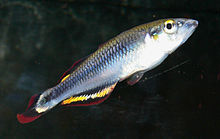
The red rainbowfish or salmon-red rainbowfish is a species of rainbowfish from Lake Sentani in Irian Jaya, Indonesia. Belonging to the family Melanotaeniidae, in the subfamily Melanotaeniinae, the Australian rainbowfishes. It is threatened in its native range, but easily bred in captivity and common in the aquarium trade.
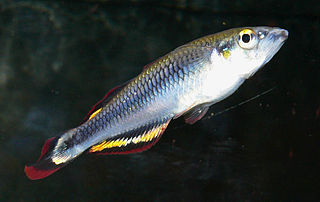
Bedotiinae are a subfamily of the rainbowfish family Melanotaeniidae, commonly known as the Madagascar rainbowfish, Madagascan rainbowfish, or Malagasy rainbowfish due to their endemism to Madagascar. It includes two genera, Bedotia and Rheocles.
Axelrod's rainbowfish is a species of rainbowfish in the subfamily Melanotaeniinae. It is found in Papua New Guinea in the Yungkiri stream in the north western part of that nation. Typically its preferred habitat is a narrow stream with gentle moving, cloudy water surrounded by lush rainforest.

Melanotaenia is a genus of rainbowfish from Australia, Indonesia, New Guinea, and nearby smaller islands.

The Lake Eacham rainbowfish is a species of rainbowfish in the subfamily Melanotaeniidae which was thought to be endemic to Yidyam, Queensland, Australia but has proven to have a wider range.

The dwarf rainbowfish is a species of rainbowfish in the subfamily Melanotaeniinae. It is known under a number of common names including diamond rainbowfish, neon rainbowfish, Praecox rainbowfish, dwarf neon rainbowfish, peacock rainbowfish, and Teczanka neonowa. It is endemic to the Mamberamo River basin in West Papua in Indonesia and common in the aquarium trade.
The Popondetta blue-eye or Popondetta rainbowfish, is a species of fish in the subfamily Pseudomugilinae. It is endemic to Papua New Guinea where it occurs at three localities around Popondetta in the east of the country. This species inhabits clear, fast flowing freshwater streams, although it has been reported from brackish water. This species was described in 1981 as Popondetta connieae by Gerald R. Allen from a typelocality of Auga Creek, about 5 kilometres (3.1 mi) south of Popondetta where Allen collected the 200 types along with Brian Parkinson. Allen gave it the specific name connieae to honour his wife, Connie, who normally prepared Allen's manuscripts for publication. This species is sought-after in the aquarium trade and is available in the European and Australian markets.
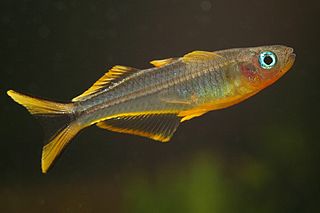
Pseudomugil is a genus of fish in the subfamily Pseudomugilinae endemic to Australia and New Guinea, where they are found in freshwater rivers and streams and bodies of brackish water.
The honey blue-eye is an endangered species of fish in the subfamily Pseudomugilinae. It is endemic to southeastern Queensland, Australia, where it is found in mildly acidic, often tannin-stained, ponds and streams in wallum habitat.
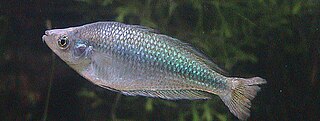
The Murray River rainbowfish, known less commonly as the Australian rainbowfish, is a species of freshwater fish endemic to southeastern Australia. The southernmost species of all rainbowfishes, these fish are very colourful, hence the name; and there is sexual dimorphism with the males being larger and more colourful than females. Murray River rainbowfish are schooling fish and will congregate near logs or riverbanks, and are a popular aquarium fish.

The Pseudomugilidae, the blue-eyes, are a subfamily of atheriniform fish in the rainbowfish family Melanotaeniidae. They inhabit fresh and brackish water in Australia, New Guinea and nearby smaller islands. Blue-eyes are small fish, typically no more than 5 cm (2.0 in) in length. Like the larger Melanotaeniid rainbowfish, they spawn all year round, and attach their eggs to vegetation.
The blue rainbowfish is a species of rainbowfish in the subfamily Melanotaeniinae which is endemic to Papua New Guinea. It is found mostly in the lower and middle Kikori drainage system.
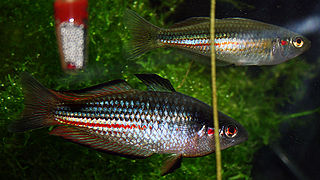
Melanotaenia duboulayi, the crimson-spotted rainbowfish, less commonly known as the Duboulay's rainbowfish, is a species of freshwater fish endemic to coastal eastern Australia. M. duboulayi has also been kept as an aquarium fish since the early 20th century, and is the original "Australian rainbowfish".

The ornate rainbowfish is a species of rainbowfish endemic to an area in eastern Australia, where it is native to coastal regions and sandy offshore islands in southern Queensland and northern New South Wales. It is the only known member of its genus. It is a popular aquarium fish.

The black-banded rainbowfish is a species of rainbowfish belonging to the subfamily Melanotaeniidae. The species is endemic to Australia. Importantly, the species is the type species of the genus Melanotaenia.

The Pacific blue-eye is a species of fish in the subfamily Pseudomugilinae native to eastern Australia. Described by Austrian naturalist Rudolf Kner in 1866, it comprises two subspecies that have been regarded as separate species in the past and may be once again with further study. It is a common fish of rivers and estuaries along the eastern seaboard from Cape York in North Queensland to southern New South Wales, the Burdekin Gap in central-north Queensland dividing the ranges of the two subspecies.
Heiko Bleher is a German researcher, author, photographer, and filmmaker. He is best known in the scientific community for his contribution to the exploration of fresh and brackish water habitats worldwide. He has discovered numerous species of fish and aquatic plant, several of which carry his name or are named in honor of Bleher's family.
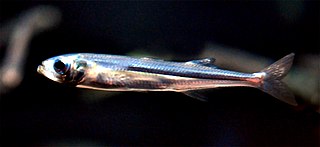
Atherinoidei is a suborder of the order Atheriniformes comprising six families, with a mainly Old World distribution, although a few species are found in the western Atlantic Ocean.

Melanotaeniinae the Australian rainbowfishes is a subfamily of the rainbowfishes of the family Melanotaeniidae. They are a group of small, colourful, freshwater fish found in northern and eastern Australia, New Guinea, islands in Cenderawasih Bay the Raja Ampat Islands in Indonesia and in Madagascar.

Pseudomugil ivantsoffi is a species of blue-eye from the subfamily Pseudomugilinae, part of the rainbowfish family Melanotaeniidae. It is endemic to Western Papua in Indonesia. It was described in 1999 by Gerald R. Allen and Samuel J. Renyaan from types collected in southern Irian Jaya at two locations one a tributary of the Kopi River approximately 1 kilometre (0.62 mi) of the Tembagapura Road and from the mile 39 Camp of the Freeport Mining Company in 1995.

